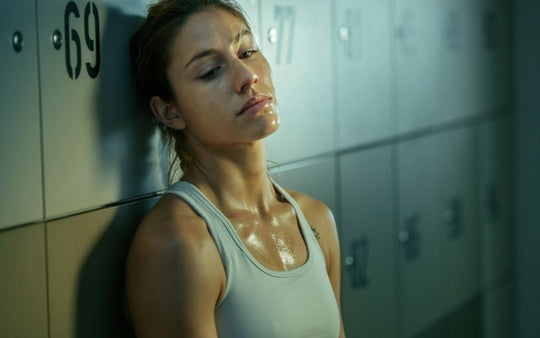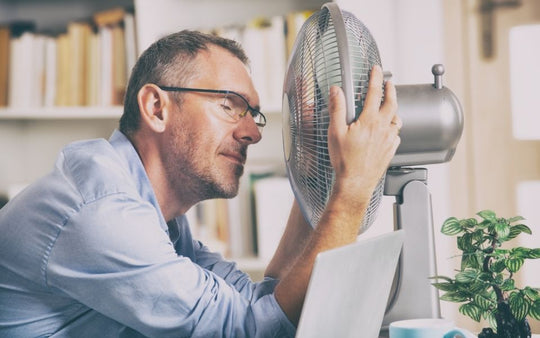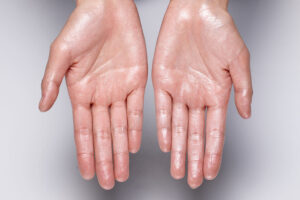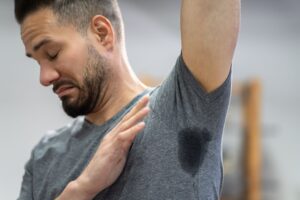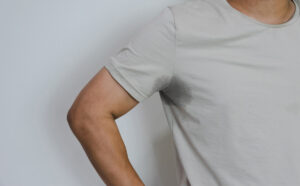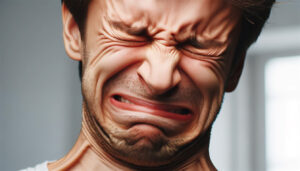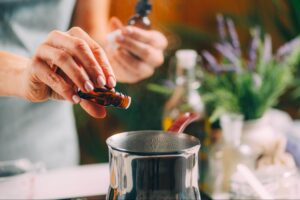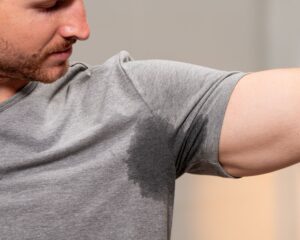Table of Contents
Does excessive sweating bother you? Keep you from being social? Or make you feel like you can’t be yourself? Hyperhidrosis may be to blame for this unexplained, often spontaneous type of extreme sweating.
Focal hyperhidrosis, also known as primary hyperhidrosis, is the most common form of hyperhidrosis. Secondary general hyperhidrosis, however, occurs more rarely and can be present since birth.
Many people struggle with excessive sweating throughout childhood and well into adulthood without ever knowing they have it.
In this article we’ll explore what focal hyperhidrosis is, what makes it different from general hyperhidrosis, its symptoms, causes, and possible treatments.
Why Do We Sweat?
We sweat to regulate our body temperature. It’s the body’s natural and healthy way to cool itself.
When the body temperature rises, our nervous system will trigger the sweat glands to release extra heat via sweat on the skin’s surface. Our body temperature fluctuates frequently and excessive sweating occurs, in most cases, due to physical activity, weather, wardrobe, diet, and common stressors.
Although sweating can be socially destructive, it’s a necessary bodily function that prevents overheating and heat stroke.
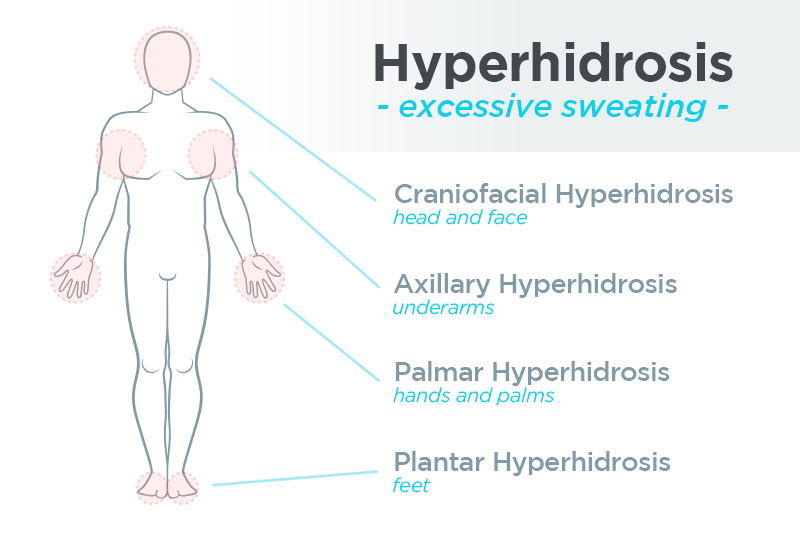
What is Focal Hyperhidrosis?
Focal hyperhidrosis affects only specific parts of the body where there are high numbers of sweat glands. It usually starts during adolescence, but can sometimes start earlier. Because it’s genetic in nature, it’s usually inherited.
There are four main body areas affected by primary hyperhidrosis:
1) Armpits – Axillary Hyperhidrosis.
2) Hands – Palmar Hyperhidrosis.
3) Feet – Plantar Hyperhidrosis.
4) Head and Face – Craniofacial Hyperhidrosis.
What Causes Focal Hyperhidrosis?
Why do some people sweat excessively, uncontrollably, and for absolutely no reason? Most types of hyperhidrosis, including focal hyperhidrosis, are caused by an over stimulation of the sweat glands. Sweat triggers also include stress or genetic factors. Unrelated health problems or diseases trigger another form of the condition (see below).
What is Secondary General Hyperhidrosis
Unlike primary focal hyperhidrosis, secondary hyperhidrosis (also known as diaphoresis) is characterized by excessive sweating all over the body.
General hyperhidrosis can be present from birth or can be caused by an underlying medical condition. Secondary hyperhidrosis can also be a side effect of certain drugs and prescription medications.
If you have one of these medical conditions and experience excessive, full-body sweating, talk to your doctor to rule out any underlying causes and see what solutions are available.
Focal Hyperhidrosis Complications
If profuse sweating goes unchecked, it can have a negative impact on your social life and even lead to minor skin infections.
Social and Emotional
This is the most obvious of profuse sweating complications. Excess underarm sweat can lead to awkward hugs, embarrassing corporate encounters, and unnecessary stress on high school and college students. Heavy armpit sweat can ultimately turn a social butterfly into a cave-dwelling hermit.
Sweaty palms can sap one’s confidence and work performance. Slippery equipment, golf clubs, keyboards, and game controllers are just a few of the annoying side effects of excessive hand sweating.
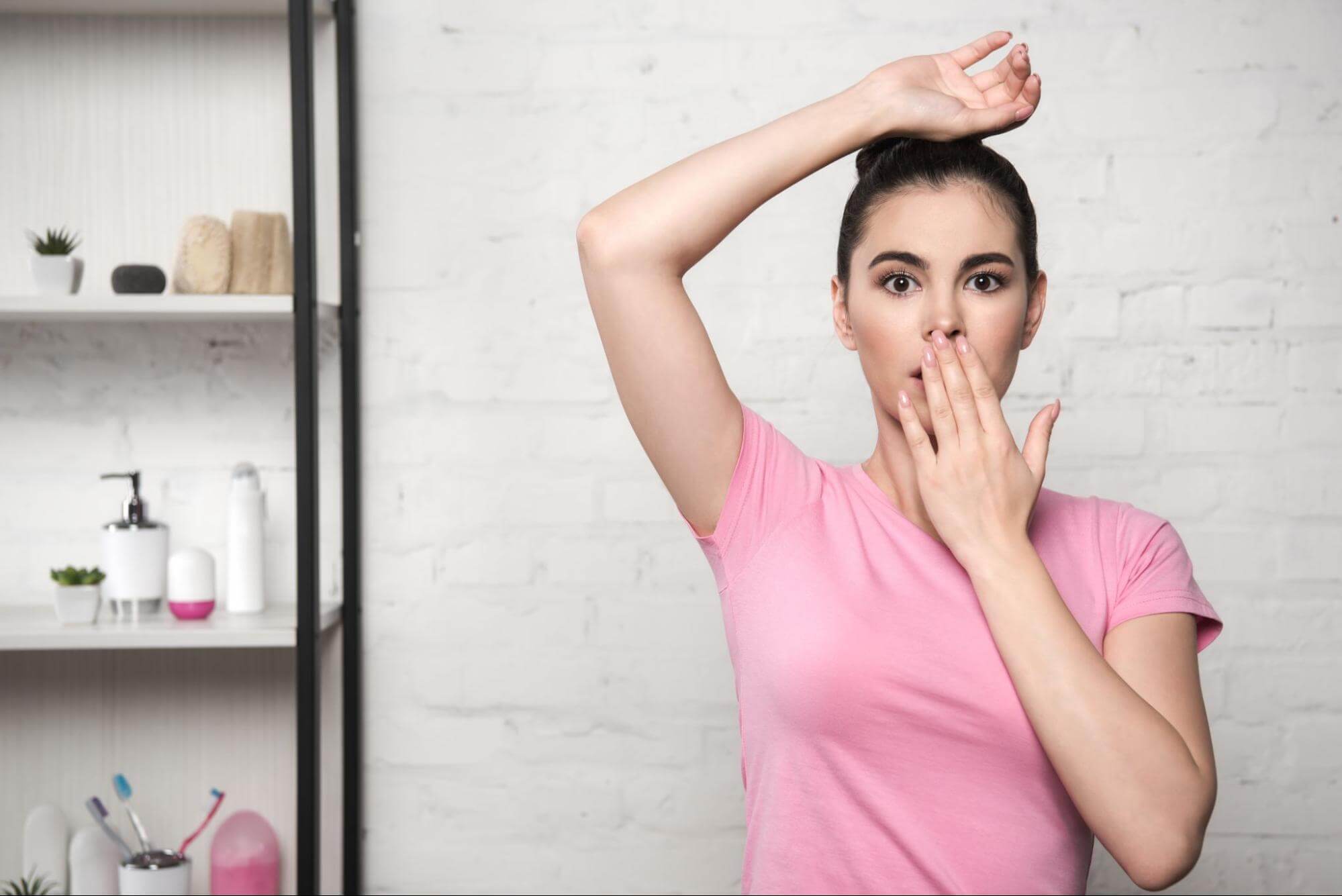
A sweaty face can quickly turn an impressive interview into an awkward distraction. The list goes on and on.
The truth is, hyperhidrosis really stinks (literally and figuratively). The really sad part is that most individuals don’t know they have it and never take the proper steps to treat excessive sweating or control it.
Skin Infections
Focal hyperhidrosis can lead to skin irritation and other minor conditions like athlete’s foot, jock itch, warts, and some serious body odor (bromhidrosis).
Other infections that can be triggered by untreated excessive sweating include dermatophytosis, pitted keratolysis, verruca plantaris, and ingrown toenails.
If you think you might have primary focal hyperhidrosis, talk to a dermatologist. Don’t suffer in silence. There are treatments and products that can help. Let’s look at some!
Focal Hyperhidrosis Treatments
There are many hyperhidrosis treatments that have proven effective, including antiperspirants, oral medications, and advanced procedures.
Prescription-Strength and Clinical-Strength Antiperspirants
Many doctors prescribe and recommend a strong antiperspirant to treat focal hyperhidrosis. Clinical-strength antiperspirants are effective as a result of their high concentration of aluminum chloride.
Aluminum chloride is the active ingredient in antiperspirant that does the actual sweat blocking. Antiperspirants can be used nearly anywhere on the body to control profuse sweating.
Some clinical-strength antiperspirants can control excessive sweating for up to four days or more with just one application.
Prescription Hyperhidrosis Creams
Prescription creams and topicals containing glycopyrrolate (also known as glycopyrronium bromide) are useful in treating craniofacial hyperhidrosis or sweating of the face and head. Glycopyrrolate is a compound used to treat ulcers and excessive drooling.
Hyperhidrosis Medications
Certain medications taken by mouth block the chemicals that allow certain nerves to communicate with each other. By cutting off nerve communication, some people have experienced reduced sweating.
These fall into two main categories: anticholinergics and beta blockers. There can be some unwanted side effects by taking these hyperhidrosis pills that include dry mouth, blurred vision, and bladder problems. Some medications that can have side effects like these include oxybutynin, glycopyrrolate, benztropine, and propantheline.
Antidepressants
Some medications prescribed for depression can also decrease the output of overactive sweat glands. These medicines may also help to decrease the anxiety that promotes extreme sweating.
Botox for Hyperhidrosis
Treatment with botulinum toxin (Botox) is a solution that temporarily blocks the nerves that cause sweating.
If you and your doctor opt for botulinum toxin injections, your skin will first be anesthetized. Each affected area of your body will receive several injections to ensure that all the nerves have been treated.
The desired effects can last 6-12 months before the treatment must be repeated. While effective, this treatment is painful and some people experience temporary muscle pain in the treated areas.
Iontophoresis
An easy way of understanding this procedure is to think of it as an injection without a needle. It is non-invasive and uses a small electric current to drive medications through the skin. Iontophoresis is often used to treat palmoplantar hyperhidrosis.
Focal Hyperhidrosis Surgery and Other Advanced Treatments
If topical or medications taken by mouth don’t relieve excessive sweating, there are several other possible treatments for hyperhidrosis. These may eliminate or at least greatly improve excessive perspiration. These include surgery or other invasive and expensive approaches. All of these must be prescribed by a doctor and administered in a doctor’s office or hospital.
Microwave Therapy
This treatment uses a device that delivers microwave energy to the targeted sweat glands. The procedure requires two 20-30 minute sessions, 90 days apart. Microwave therapy is expensive and may not be widely available. Unwanted side effects include a sensation change in the skin and possible discomfort.
miraDry
miraDry is a newer axillary hyperhidrosis treatment that also uses microwave energy to destroy targeted sweat glands. A doctor administers local anesthesia and then uses a hand-held device to suck sweat glands closer to the skin surface. The device then heats and destroys the underarm sweat glands while cooling the top layers of skin. miraDry has proven effective but will leave a considerable dent in your wallet.
Sweat Gland Removal
If profuse sweating is affecting only the armpits, removing the sweat glands may offer a permanent solution. Suction curettage is a minimally invasive procedure. A dermatologist will insert a suction tool into two small incisions. They will then remove the sweat glands. This is a popular treatment for excessive sweating when other remedies fail to produce positive results.
Nerve Surgery (Sympathectomy)
This is a procedure in which a surgeon cuts, burns, or clamps spinal nerves that control sweating in the hands (palmar hyperhidrosis). Sometimes this treatment causes excessive compensatory sweating in other parts of the body.
Lifestyle Hacks to Help Reduce Effects of Focal Hyperhidrosis
For many who suffer from heavy sweating, there are simple ways to reduce sweating. Lifestyle and other non-prescription remedies may also be good places to start searching for relief. These are basic, common-sense ideas but they’re worth noting.
Bathe Daily
Regular bathing will help keep skin-borne bacteria in check. When finished, dry thoroughly with a clean towel especially between toes and under the arms. If you don’t have access to a shower, try using cleansing shower wipes.
Go Barefoot to Help Sweaty Feet
If going without shoes and socks isn’t possible, at least slip out of the shoes now and then throughout the day. Give your feet a chance to air out.
Choose Shoes and Socks Made of Natural Materials
Shoes made of leather or natural fabrics can help prevent sweaty feet by allowing your feet to breathe. During periods of high activity or exercise, moisture-wicking socks are a good choice.
Wear Light Fabrics and Loose-Fitting Clothing
It’s a good idea to wear natural fabrics like cotton, wool, or silk. These fabrics allow your skin to breathe. When exercising, wear moisture-wicking clothing. Dress in removable layers to avoid overheating.
Sweat-Proof Undershirts
While a sweat-proof undershirt won’t stop you from perspiring, it can absorb sweat throughout the day. This creates the perception of dry underarms and can keep embarrassing sweat marks and sweat stains at bay.
Focal Hyperhidrosis Remedies and Natural Treatments
There are many who may prefer a natural treatment for hyperhidrosis. These include the use of herbs, diet, vitamins, supplements, and relaxation techniques.
Yoga

Practicing yoga can relax the body and reduce stress.
Acupuncture
There are a number of case studies indicating that acupuncture may be effective for some sufferers of focal hyperhidrosis. The duration of the improvement has yet to be determined.
Hypnosis
Hypnosis by a hypnosis practitioner or self-hypnosis have been suggested as alternative treatments. According to first-hand reports, positive results are dubious.
Fitness and Hygiene
Regular exercise and avoiding carrying too much excess weight can be key factors in managing sweating. Also reducing or eliminating the use of skin lotions and makeup—or finding natural substitutes.
Diet
Some dieticians recommend a diet of 80% plant-based foods to help control sweating. Along with plant-based (preferably organic) foods, they recommend eliminating MSG, GMOs, and all trans fats. If meat is included, eat only small amounts of unprocessed, grass-fed meats. Vitamins B and D can help too.
Herbal Remedies
Advocates of herbal solutions have identified several herbal remedies that reportedly help manage hyperhidrosis. These include witch hazel, sage, valerian root, St. John’s wort, burdock and astragalus among others. Many are astringents that shrink skin pores when applied topically. Others exert a positive effect on the endocrine system when taken internally.
Focal Hyperhidrosis Frequently Asked Questions
If you’re one of the estimated 15 million who suffer from hyperhidrosis, you probably have questions. Here are some of the most asked questions regarding excessive sweating and hyperhidrosis.
Do I Have Hyperhidrosis?
If you experience episodes of excessive sweating that occur at least once a week and for no clear reason you probably have focal hyperhidrosis. These include night sweats.
What is the Best Treatment for Focal Hyperhidrosis?
Everyone is different and each person will react differently to sweating treatments. Depending on the seriousness of your hyperhidrosis symptoms, you’ll want to review the available treatments and decide which is best for you. Don’t hesitate to consult your doctor.
Is Focal Hyperhidrosis Curable?
As focal hyperhidrosis can be caused by a number of things, there really isn’t a one-size-fits all cure. However, many of the treatments described above are effective and can reduce or eliminate symptoms. They can get you feeling good again and functioning more effectively. Life can be better!
You might also like...

Why Do I Sweat So Much? And So Easily?
WHY DO I SWEAT SO MUCH? : ARTICLE CONTENTS Sweating a lot? … when you workout, sleep, after eating, or
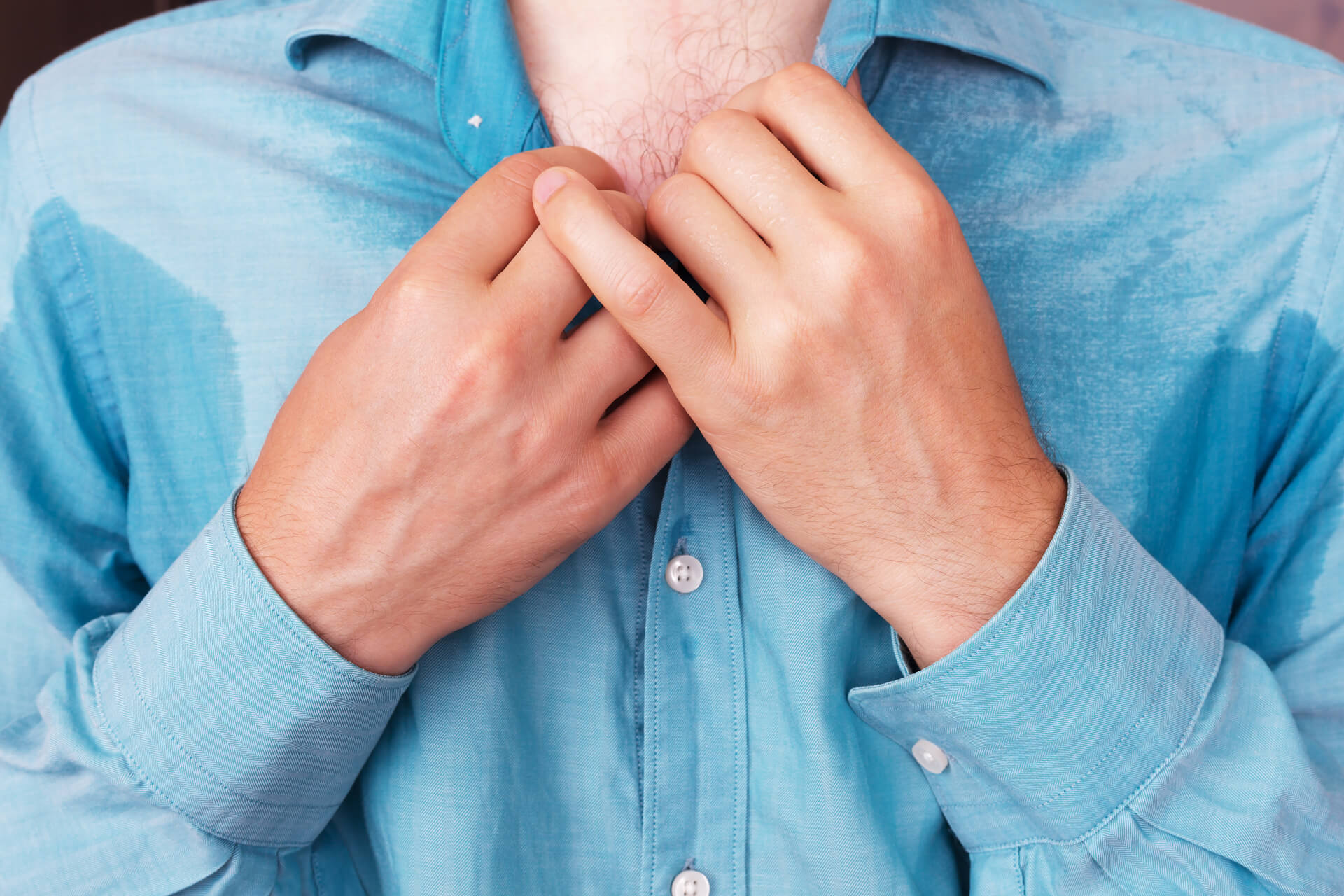
Is There a Hyperhidrosis Cure? 11 Hyperhidrosis Treatment Options
If you’re one of the roughly 8 million Americans who deal with excessive sweating (also known as hyperhidrosis), this article

How to Stop Sweating So Much? 9 Tips to Beat Unwanted Sweat
If you’ve ever suffered through an awkward sweaty hug, a slippery handshake, or a sweat-soaked job interview — this article



